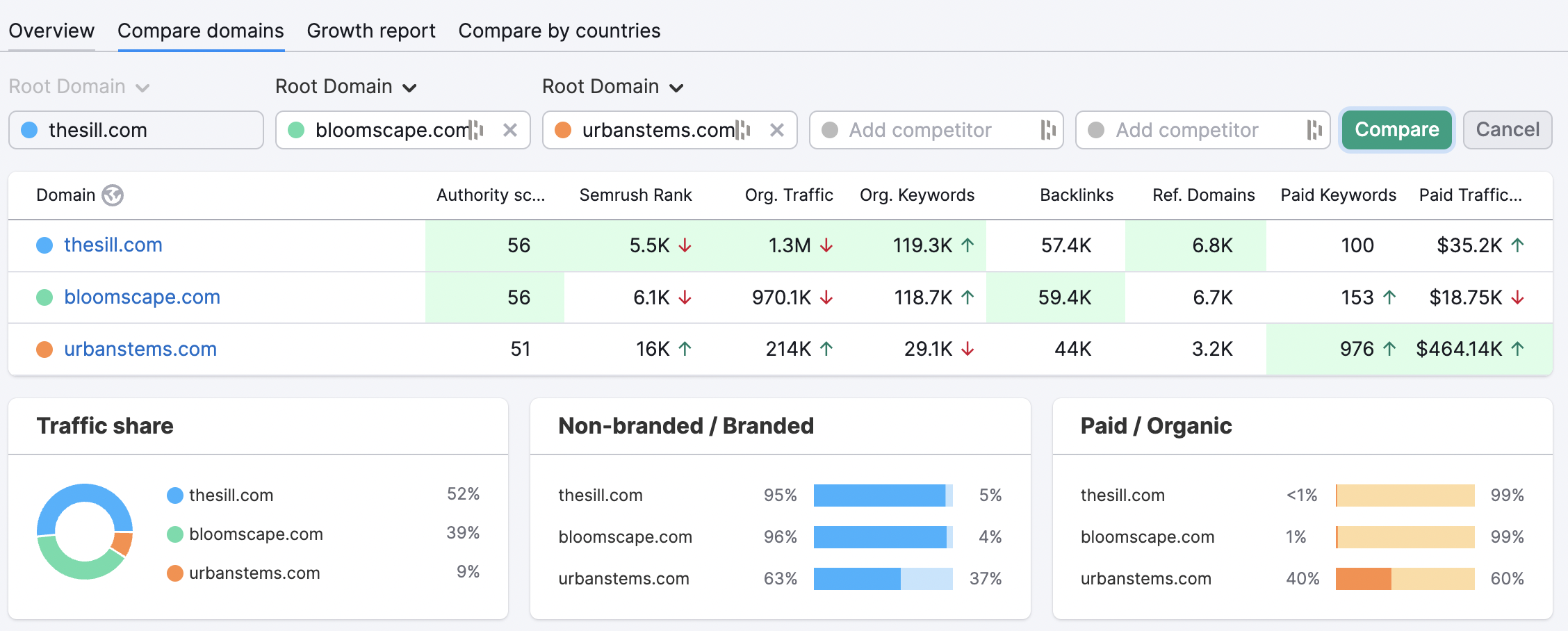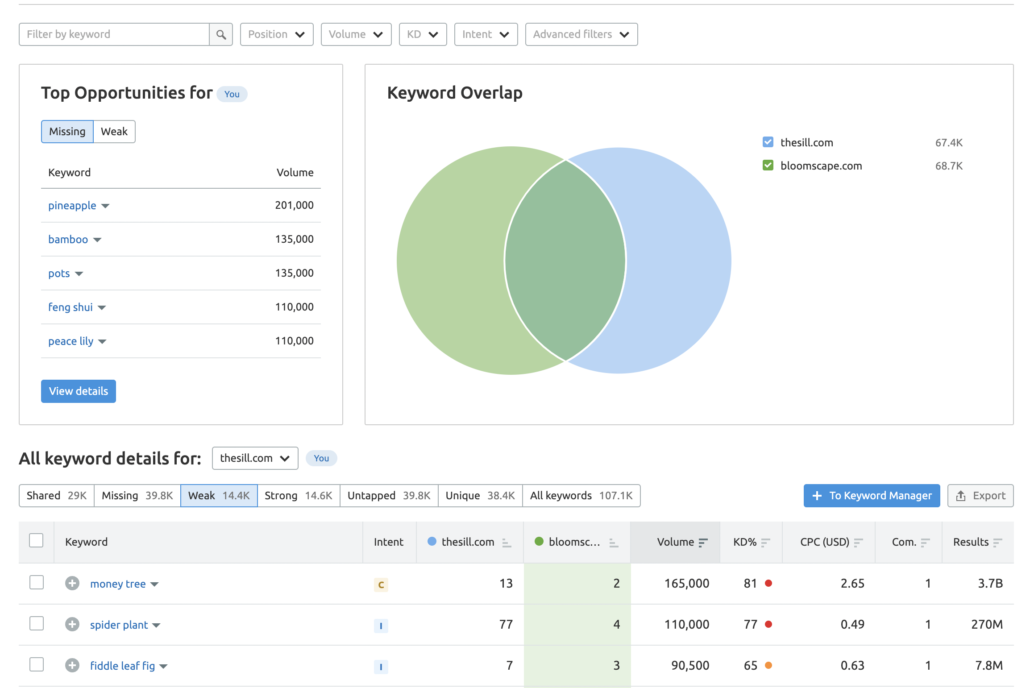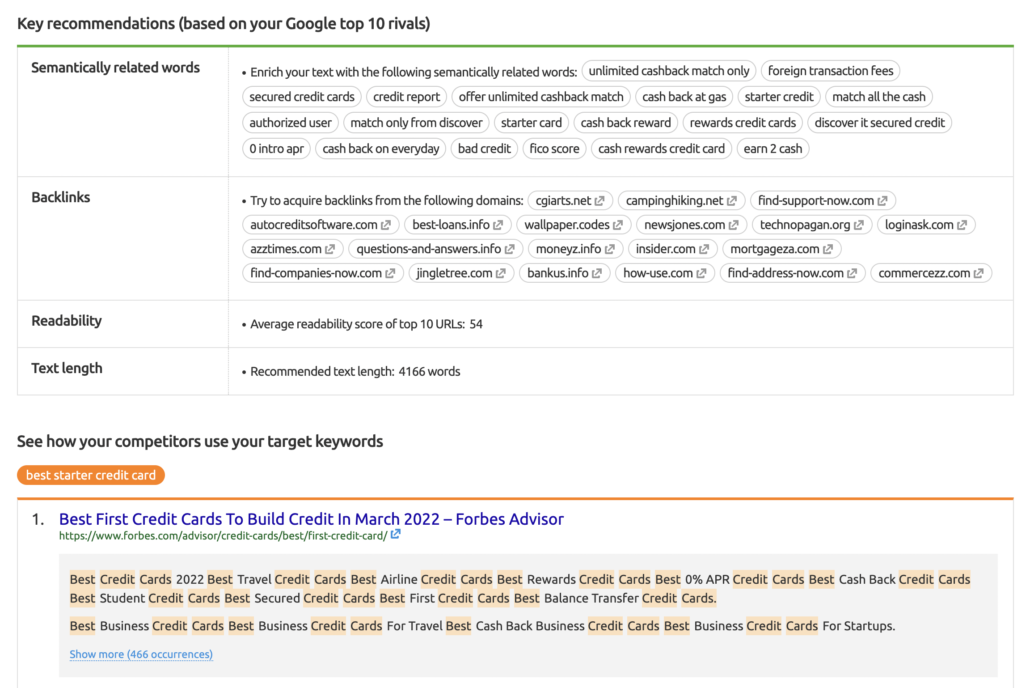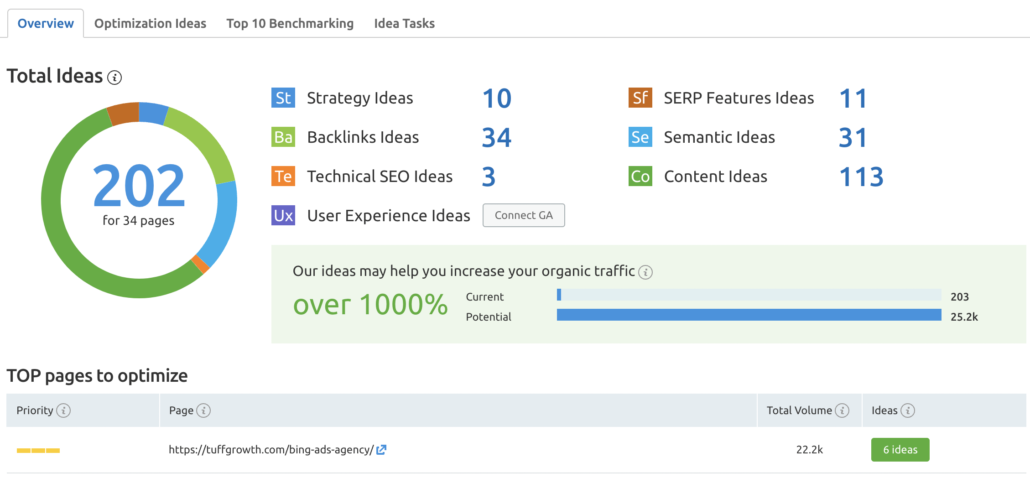Little-Known Ways to Leverage SEMrush
At Tuff, we use SEMrush every day. If you aren’t familiar with SEMrush, it is a powerful tool to conduct marketing research.
You can run technical SEO audits, keyword research, competitive analysis, and much more.
With SEMrush, you get a lot of data at your fingertips. However, the challenge with comprehensive tools like SEMrush is figuring out how to use them effectively.
How can you leverage SEMrush to get better marketing results? Sit tight, and read on.
- Identify your search competitors.
- Compare your competitors’ traffic (and where it comes from).
- See how much competitors spend on paid traffic.
- Prioritize keyword opportunities with the Keyword Gap Tool and filters.
- Outline content with the SEO Content Template.
- Track keyword movement.
- View your share of search.
- Get SEO ideas from the On-Page SEO Checker.
1. Identify your search competitors.
Each company has market competitors and search competitors. Market competitors are the companies you directly compete with–you have similar target audiences and products. Some examples of market competitors are:
- Samsung and Apple
- Peloton and NordicTrack
- Nike and Adidas
- McDonald’s and Burger King
Search competitors, also known as organic competitors, are the sites that show up in search results for the same queries or keywords that you are targeting.
For instance, if you are a company selling indoor house plants online, you might be trying to rank for queries like “indoor succulents”. When you search “indoor succulents”, you will be competing against blogs about plant care as well as direct competitors.
Sometimes the two buckets overlap, but not always. When we do a competitive analysis, we look at both.
Here’s how to find your search competitors in SEMrush:
- Go to Organic Research, add your site, and search by Root Domain.
- Click on the Competitor tab inside organic research to see your results.
You’ll see a graph called “competitive positioning map”. This shows your top five search competitors based on your current content rankings. You can also see a full list of organic competitors. Note that your market competitors might also be search competitors, but again, not always.
For fun, let’s see what a competitive positioning map looks like if we use Webflow as an example.
As a website builder, Webflow has a lot of market competitors like WordPress, Shopify, and Squarespace, but currently, Wix is their biggest search competitor.
Once you have a clear picture of who you are competing with, you can learn how to beat them–with a little help from SEMrush.
2. Compare your competitors’ traffic (and where it comes from).
The amount of competitive data that you can pull from SEMrush goes beyond just identifying competitors. In fact, you can learn exactly what marketing strategies competitors use to get traffic within SEMrush.
Take your top competitors–these can be a combination of search and market competitors–and compare them.
Here’s how:
- Go to SEMrush’s Domain Overview and enter your site domain.
- Click on Compare Domains and add up to four competitors.
- Hit compare.
Let’s take the house plants example that we used earlier. If we use The Sill as an example, SEMrush will generate a competitive report that looks like this:
There’s a lot in this table, but for our purposes, we’re going to look at these columns:
- Organic traffic – how much traffic comes from organic search monthly
- Organic keywords – how many keywords a site ranks for
- Paid traffic – the average monthly spend on paid traffic
As you can see, The Sill is beating Bloomscape and Urbanstems at organic search. Over 1.3 million in traffic each month comes from organic search alone.
If you look at the non-branded/branded section, you can also get a sense of where that traffic is coming from.
With this, you can view the percent of non-branded and branded traffic. If a company has significantly more branded traffic than non-branded, it usually signals that most of their organic traffic is direct, meaning it comes from people that already knew the company. They likely don’t have a strong SEO content strategy yet.
3. See how much competitors spend on paid traffic.
As a holistic growth marketing agency, we know that some of the best and most sustainable results happen when paid and organic marketing efforts work together.
If a company only focuses on paid traffic, it could end up spending a lot on short-term wins and miss out on the long-term growth opportunities from SEO. Knowing how much your competitors spend on paid can help you determine your own ad budgets, but it can also tell you why competitors are beating you.
For example, Urbanstems has a large ad budget ($460K+ according to SEMrush), but lower organic traffic than The Sill. On the other hand, the majority of The Sill’s traffic is from organic search, and they are able to have lower ad costs in comparison ($35K).
4. Prioritize keyword opportunities with the Keyword Gap Tool and filters.
There are many ways to conduct keyword research. One way to get started is to learn from your competitors.
The idea isn’t that you should copy your competitors. Rather, by knowing what keywords your competitors rank for, you can identify your strengths and weaknesses. This will help you to identify growth opportunities for keywords and content.
Here’s how:
- Go to the Keyword Gap tool.
- Enter your domain and your top competitor. You can technically enter up to four competitors, but we recommend one at a time.
You’ll see a report like this one.
As you can see, there are thousands of keyword results. If you’re just starting out, it can be hard to identify which opportunities you should prioritize first.
Here’s an insider tip for using SEMrush: filters are your friend. These are some of my favorite filters to use to help prioritize keyword research:
- Position – Go to the position filter dropdown and competitor domain. Then, depending on the number of results you have, filter by top 10 or top 20.
This tells you that you or your competitors rank in the top 10 or 20 search results. These are usually the most relevant terms for your business, and the top traffic drivers.
- KD – In the SEO world, we look for keywords that hit the sweet spot of high search volume and low difficulty to rank (keyword difficulty or KD). Most companies will want to stay below 70 keyword difficulty.
To filter this, go to the KD and set a custom range between 0 to 70.
- Intent – Great SEO content has the potential to also lead to conversions. The key is figuring out which queries are high-intent.
High-intent keywords are my personal favorite because when someone searches for them, it is a strong indicator that they are looking to buy. If you can rank for high intent keywords, you could bring in more organic conversions
To filter in SEMrush, go to Intent and choose commercial.
Now, with the Keyword Gap and some filtering, you’ll have a solid list of keywords that you can prioritize even further based on relevancy for your business.
5. Outline content with the SEO Content Template.
Once you have identified a target keyword for a piece of content, then drop it into the SEO Content Template. Choose the country, region, or city that you are targeting, and hit create SEO Template.
This tool helps you structure SEO content so that it performs better. For example, a fintech company might be trying to rank for a keyword like “best starter credit card“. When you put the keyword into the SEO Content Template, it will generate a template like this one.
We can use this to start a SEO outline, but we don’t want everything here. These are the most important sections to get you started:
- Semantically related keywords – Copy and paste the semantically related keywords. These are the words that the top-ranking results use when talking about “best starter credit card”.
Your target keyword is the priority, but try incorporating these words throughout your content at least once to outrank the existing search competitors.
- Text length – This indicates about how many words you will need to write. For this one, the suggested word count is over 4,000, which is pretty lengthy. With a length like that, this post is likely going to be pillar content.
- Competitors – To beat your search competitors, the quality of the content you create has to be greater than their content. Inside the SEO Content Template, you can see the top organic results and how they use your keyword to structure content.
6. Track keyword movement.
SEMrush also makes it easier to track your keyword movement with the Position Tracking tool, but there’s much more to it than that.
To use position tracking, you first must set up a Project in SEMrush. You can do this by going to Projects, clicking the Create Project button, and entering your website details.
Now, you can go to the position tracking tool. Here’s how:
- Select your project, and hit set up.
- Set your targeting parameters. You can set the search engine, device, location, and language.
- Add your keywords. You can copy and paste them in or import a file of your target keywords list.
- Click Start Tracking and SEMrush will gather the data.
SEMrush’s position tracking is powerful because you can track:
- Visibility – This score shows the percent of visibility, or what percent of your keywords appear in the top 100 results in Google.
- Positive and negative movement – See what positions you have gained and which you’ve lost by looking at positive and negative impact. Your wins will be in green up arrows and losses are red down arrows.
Maintaining a top position once you’ve moved up in search results can be a challenge. Position tracking gives you real-time keyword monitoring, so you can identify a drop in position and refresh content when you need to.
7. View your share of search.
There are many ways that you can view competitors inside Position Tracking. If you have a business plan, you can track your share of voice, also called share of search.
Share of voice measures brand awareness by comparing how many mentions your brand has in a channel compared to your industry competitors. It usually is used for branded terms, but SEMrush can measure it by all keywords in search, non-branded and branded.
The Share of Voice feature counts the ratio of organic traffic that all of your keywords get from search. Then, it compares that to your organic competitors’ share of search inside a line graph.
With it, you get a clear picture of the competitive landscape. You can see which brands are dominating organic search, and how you stack up against them.
8. Get SEO ideas from the On-Page SEO Checker.
Last but not least, if you are still searching for opportunities to improve your SEO, SEMrush’s On Page SEO Checker can help.
It compiles many different on-page SEO elements from title tags and meta descriptions to readability and even some technical SEO and off-page SEO items like backlinks into one dashboard.
Here’s what it looks like in SEMrush.
It breaks the information down into individual landing pages, so you can click on the ideas and see exact recommendations for content, backlinks, technical SEO, and user experience.
However, to view user experience ideas, you have to connect SEMrush to Google Analytics.
Like any tool, SEMrush can be used to make smarter decisions but it can’t implement the suggested fixes. It can also take some time to learn how to best leverage SEMrush to level up your SEO strategy. These tips can help you get started.











